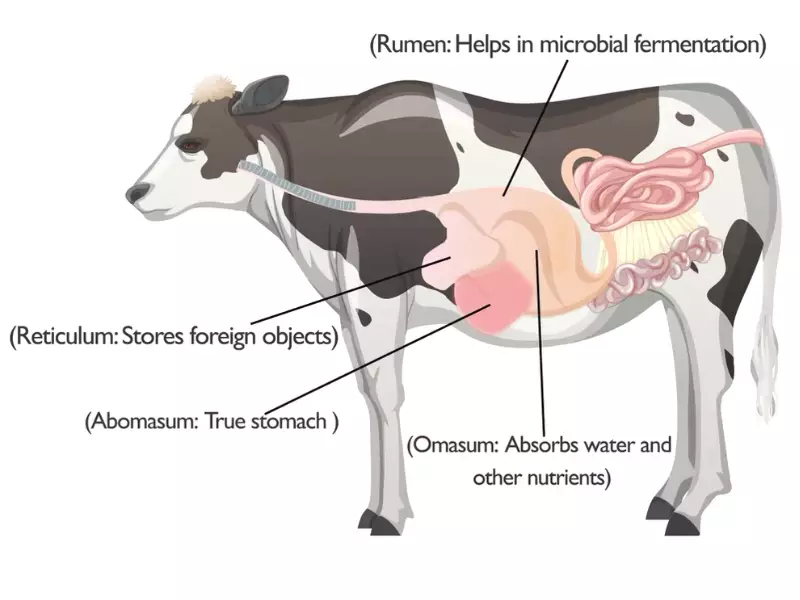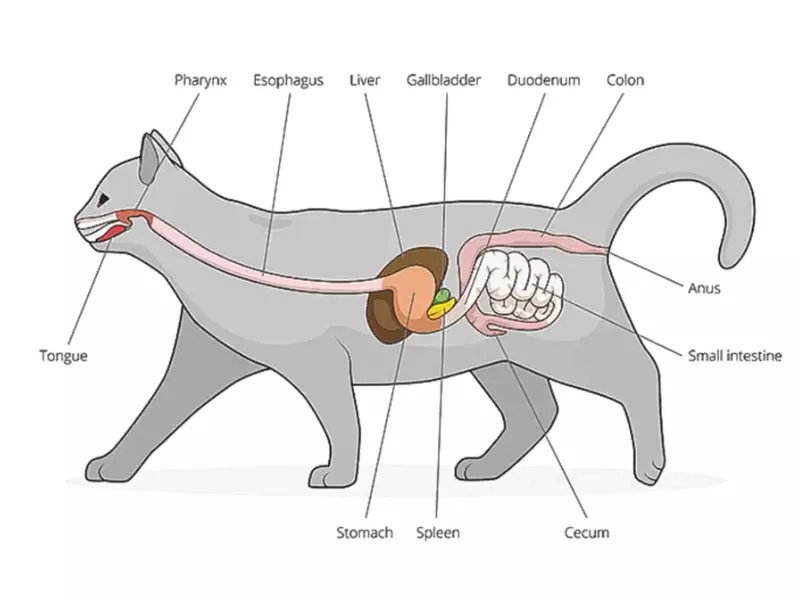The digestive systems of herbivores and carnivores are finely tuned machines, evolved over millions of years to process specific types of food efficiently. These systems reflect the dietary habits of the animals, playing a crucial role in nutrient absorption and energy conversion. While at a glance, the basic function of breaking down food might seem similar, the differences are profound and fundamentally shape the anatomy, physiology, and even the behavior of these creatures.
Herbivores are animals that primarily consume plant matter, which is tough and fibrous, requiring a specialized digestive system to extract nutrients. Carnivores, on the other hand, feed on animal flesh, necessitating a different set of digestive adaptations to process proteins and fats effectively. The key differences lie in the complexity and length of the digestive tract, the presence of certain digestive organs, and the enzymes produced for breaking down food.
The exploration of these differences reveals not just the marvels of evolutionary adaptation but also provides insights into the ecological roles of various species. By understanding the digestive mechanisms of herbivores and carnivores, we can appreciate the intricate balance of nature, where every organism plays a pivotal role in sustaining ecosystems. This article aims to shed light on these fascinating differences, highlighting how each system is uniquely designed to maximize the dietary benefits of its respective food sources.

Digestive Basics
The digestive system is a complex network designed to turn food into energy and nutrients to feed the body. While all animals need to eat to survive, the way they digest their food varies greatly between herbivores and carnivores. The main difference lies in what they eat: herbivores consume plants, while carnivores eat meat. This fundamental dietary distinction has led to significant adaptations in their digestive systems.
Herbivore Digestion
Overview of Herbivore Digestive Process
Herbivores have developed a digestive system that is capable of breaking down tough plant materials. This process is slower and more complex than that of carnivores, due to the need to extract nutrients from fibrous plants. The key to their digestion lies in the mechanical and microbial breakdown of cellulose, a major component of plant cell walls.
Carnivore Digestion
Overview of Carnivore Digestive Process
Carnivores, in contrast, have a digestive system optimized for processing meat. Their digestive process is generally quicker and less complex, focusing on the breakdown of proteins and fats. The acidic environment of their stomachs plays a crucial role in this process, killing bacteria and aiding in the breakdown of muscle and bone.
Mouth and Teeth
Herbivore Adaptations
Types of Teeth
Herbivores have flat, broad teeth designed for grinding plants. These include incisors for cutting and molars for grinding. The diversity in tooth structure reflects the variety of plant materials they consume.
Chewing Mechanism
The chewing mechanism of herbivores is unique, with a side-to-side motion that is efficient for breaking down fibrous plant matter. This action not only mechanically breaks down food but also increases the surface area for microbial action in the stomach.
Carnivore Adaptations
Types of Teeth
Carnivores possess sharp, pointed teeth for tearing flesh, including canines for gripping and carnassials for shearing meat. This tooth structure minimizes the need for chewing, allowing for a bite and swallow mechanism.
Bite and Swallow Mechanism
The bite and swallow approach of carnivores is straightforward: tear the meat and swallow it with minimal chewing. This method is efficient for a diet that is rich in protein and fat, requiring less mechanical breakdown before reaching the stomach.
Stomach and Enzymes
Herbivore Stomach
Structure and Function
The stomach of herbivores can be single-chambered or multi-chambered, depending on the species. This structure is designed to maximize microbial digestion, with a pH that supports a rich microbial population.
Role of Microbes
Microbes play a crucial role in breaking down cellulose, converting it into fatty acids that the herbivore can absorb as nutrients. This symbiotic relationship is essential for nutrient extraction from plant materials.
Carnivore Stomach
Acidic Environment
The stomach of carnivores is highly acidic, creating an environment that kills bacteria and begins the enzymatic breakdown of proteins. This acidity is crucial for digesting meat efficiently and safely.
Enzymatic Breakdown
Enzymes in the carnivore’s stomach further break down proteins and fats into smaller molecules that can be easily absorbed. This process is relatively fast and efficient, reflecting the carnivore’s dietary needs.
Intestinal Tract
Herbivore Intestines
Length and Complexity
The intestinal tract of herbivores is long and complex, reflecting the need to extract a wide range of nutrients from plant materials. This length provides ample time for fermentation and absorption.
Fermentation Process
The fermentation process, occurring in parts of the intestine and in specialized organs like the cecum, allows for the breakdown of cellulose into usable energy. This process is aided by a rich microbial flora.
Carnivore Intestines
Shorter Length
Carnivores have a shorter intestinal tract compared to herbivores, reflecting their diet’s easier-to-digest nature. This shorter length allows for rapid digestion and absorption of nutrients.
Absorption Efficiency
Despite its shorter length, the intestinal tract of carnivores is highly efficient at absorbing proteins and fats, the main components of their diet. This efficiency supports their high-energy needs and fast-paced lifestyle.

Nutrient Absorption
Herbivores
Fiber and Carbohydrate Processing
Herbivores are masters at extracting nutrients from plants, a task that requires specialized adaptations. Their digestive systems are designed to break down fiber and carbohydrates, which are abundant in their plant-based diets. The process involves mechanical breakdown through chewing, followed by chemical digestion with the help of microbial fermentation in the stomach or cecum. This symbiotic relationship with gut microbes enables herbivores to access nutrients bound within plant cell walls, converting them into volatile fatty acids that the animal can use for energy.
Carnivores
Protein and Fat Assimilation
Carnivores, on the other hand, excel in protein and fat assimilation. Their digestive systems are optimized to handle a high-protein diet, with a highly acidic stomach that denatures protein and activates digestive enzymes. The small intestine plays a crucial role in absorbing these nutrients, where enzymes break down proteins and fats into amino acids and fatty acids, respectively. This efficient process ensures that carnivores quickly get the energy and building blocks needed for growth and repair.
Energy Extraction
Efficiency in Herbivores
Slow but Thorough
The energy extraction process in herbivores is slow but thorough, allowing them to maximize the nutritional value of their plant-based diets. Despite the low energy density of plants compared to meat, herbivores benefit from their ability to process large volumes of plant material. This slow digestion process, particularly the fermentation of cellulose, enables them to extract a significant amount of energy from their food, although it requires a larger digestive system and more time.
Efficiency in Carnivores
Rapid and Intense
Carnivores experience a rapid and intense energy extraction process, aligning with their high-energy needs and hunting lifestyle. Their digestive systems are designed to quickly metabolize proteins and fats, providing a burst of energy essential for their active pursuits. This efficiency means carnivores can spend less time eating and digesting, maximizing their time for hunting and territorial activities.
Evolutionary Adaptations
Herbivore Evolution
Dietary Changes and Digestive Adaptations
The evolution of herbivores is a fascinating story of dietary changes and digestive adaptations. As plants evolved, herbivores developed complex stomachs and lengthened intestines to deal with new types of plant defenses like tough cellulose and toxic compounds. This evolutionary arms race led to the diversification of herbivores, each with unique adaptations to their preferred plant foods. For instance, ruminants like cows have a multi-chambered stomach that allows for efficient microbial fermentation, a key adaptation to their grass-based diets.
Carnivore Evolution
Hunting Strategies and Digestive Optimization
Carnivore evolution is closely tied to their hunting strategies and digestive optimization. As prey species developed defenses, carnivores evolved sharper teeth and stronger jaws for capturing and consuming them. Alongside these physical adaptations, their digestive systems became more efficient at processing meat quickly, ensuring they could make the most of each kill. This co-evolution between carnivores and their prey has led to a dynamic balance within ecosystems, where speed, stealth, and strength are critical for survival.
Environmental Impact
Herbivore Systems
Ecosystem Roles and Contributions
Herbivores play vital roles in their ecosystems, contributing to the health and diversity of their environments. Through their feeding activity, they help in seed dispersal and the cycling of nutrients, promoting plant growth and diversity. Large herbivores can also shape landscapes, preventing overgrowth and maintaining open habitats that benefit a wide range of species. Their digestive processes, particularly fermentation, contribute to the soil’s nutrient content, further supporting ecosystem productivity.
Carnivore Systems
Predator-Prey Dynamics and Balance
Carnivores are crucial for maintaining the balance in ecosystems through predator-prey dynamics. By controlling the population of herbivores, they prevent overgrazing and ensure that vegetation remains diverse and abundant. This top-down regulation is essential for the health of ecosystems, contributing to biodiversity by allowing a wider range of plant and animal species to flourish. Carnivores also help in disease control, by preying on the sick and weak individuals, thereby supporting the overall health of prey populations.
Frequently Asked Questions
What are the main differences in teeth between herbivores and carnivores?
Herbivores have flat, broad teeth designed for grinding tough plant materials, while carnivores possess sharp, pointed teeth suited for tearing flesh. This distinction reflects their dietary needs, with each type of dentition optimizing the animal’s ability to process its primary food source efficiently.
How does the digestive system of herbivores handle cellulose?
Herbivores often have complex, multi-chambered stomachs or an enlarged cecum that houses bacteria capable of breaking down cellulose, a major component of plant cell walls. This symbiotic relationship allows them to extract nutrients from fibrous plant material, which is otherwise indigestible for many animals.
Why do carnivores have a shorter digestive tract?
Carnivores have a shorter digestive tract because their diet of meat is easier to digest and requires less time to break down than the fibrous plant material herbivores consume. This efficiency allows for a quicker nutrient absorption and energy conversion process, suited to their high-protein diet.
Can omnivores digest both plant and animal matter efficiently?
Omnivores have digestive systems that are a compromise between those of herbivores and carnivores, enabling them to process both plant and animal matter. They possess a variety of enzymes and a moderately complex digestive tract that can handle a diverse diet, though they may not be as efficient in processing either type of food as specialists.
Conclusion
The digestive systems of herbivores and carnivores are a testament to the diversity of life and the specialization that occurs in nature. These differences underscore the evolutionary paths taken by various species to survive and thrive on the planet, each adapted to its niche and dietary requirements. The intricacies of their digestive processes not only reflect the complexity of biological systems but also the interconnectedness of life, where each organism plays a role in maintaining the delicate balance of ecosystems.
Understanding these distinctions enriches our appreciation of the natural world, highlighting the importance of biodiversity and the need to preserve habitats that support this diversity. As we continue to explore and learn about the various life forms that share our planet, we gain insights into the marvels of evolution and the intricate mechanisms that sustain life in its myriad forms.
